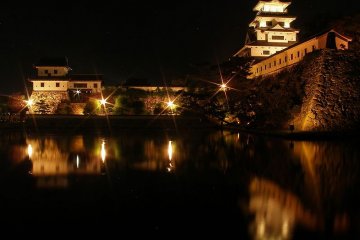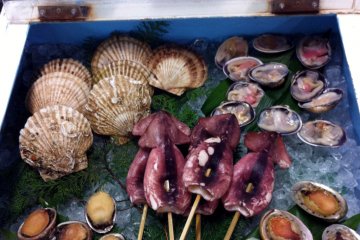
อิโซไครากุ โรบาต้ายากิ ในอิมาบาริ
Anonymousเมื่อถามพนักงานโรงแรมว่าพอจะแนะนำมื้อค่ำอร่อยๆที่ไหนให้ได้บ้าง พนักงานแนะนำร้านอิซากาว่า ซึ่งเป็นร้านอาหารที่มีเมนูปลาดิบหรือซาซิมิ

There is no better way to see the Kurushima Kaikyo Bridge and its stretch of the Seto Inland Sea than from the top of Mount Kiro, at the southernmost point of Oshima island. On particularly clear days, the spectacular view extends to the jagged summit of Ishizushi, the largest mountain in western Japan, and was named one of the 88 best sceneries in Shikoku. The observatory park on Mount Kiro was designed by Pritzker Architecture Prize-winner Kengo Kuma; the sleek, metallic observation point goes nicely with the surrounding flora, which is preserved to maintain the natural beauty of the site.
The numerous stairwells and decks make for a 360-degree view of the sea, which is especially breathtaking at sunset, as the distant mountain ranges fade to blue and a warm-toned sky is reflected on the water. At night, the bridge is illuminated. In spring, the forested region of this panoramic view is dotted with cherry blossoms.
It’s possible that you’re biking since the park is only a few minutes away from the Shimanami Expressway, a popular and famously well-organized cycling route that spans several islands, including Oshima. Getting to the summit involves a steep ride and many steps, but the view is well worth it, not to mention the public restroom facility and kiosk.
A 20-minute drive from Oshima-Minami Interchange.

เมื่อถามพนักงานโรงแรมว่าพอจะแนะนำมื้อค่ำอร่อยๆที่ไหนให้ได้บ้าง พนักงานแนะนำร้านอิซากาว่า ซึ่งเป็นร้านอาหารที่มีเมนูปลาดิบหรือซาซิมิ

Protruding from a concrete landscape—one of the tallest things in sight—is Imabari Castle, in the coastal city of the same name. This structure is one of three Mizujiro, or “castles on the sea,” in Japan. Construction began in 1602 under the local feudal lord and eminent designer of castles Todo Takatora. In 1635, Matsudaira Sadafusa, the nephew of the famous shogun Tokugawa Ieyasu, became the owner; Imabari’s position near the Seto Inland Sea provided a strategic advantage for controlling maritime traffic. With the Meiji Restoration, however, the Matsudairas fell out of power and many of the buildings on the compound were disassembled. In 1980, the city rebuilt the tenshu, or keep, out of concrete and ever since has been erecting old buildings loyal to original techniques and materials. Nowadays Imabari Castle is noted for its seawater moat (it stands right by a port), which, centuries before, would have protected against arrows and other weapons. The keep has five layers and six stories, offering wonderful views of both city and sea, as well as the Kurushima Kaikyo Bridge. Picturesque view aside, the castle itself warrants close scrutiny. From dusk to 11 p.m., illuminations cast a warm glow on the white walls and multicolored stone. If you look for long enough, you can see large fish jumping out of the moat. Inside are numerous artifacts detailing the feudal history of the area, including suits of armor that belonged to the feudal lords, clothing, weapons and art. A smaller gallery even touches on the natural history of Imabari, exhibiting stuffed animals and fossils. Also on the grounds is a magnificent statue of the designer Todo Takatora on horseback, as well as an air raid siren erected during wartime. For ¥500, visitors can view the exhibits or even explore the Shinto shrine on site.

อิกิ-อิกิกัน (Iki-ikikan) เป็นสถานีหยุดพักริมถนนที่มีร้านอาหาร แผงขายอาหาร ห้องน้ำ และสถานที่ที่บาร์บีคิวปลา ตั้งอยู่บนเกาะโอะชิมะ บนทางหลวงชิมะนะมิ

ทางหลวง ชิมะนะมิ ไคโดะ ระหว่าง อิมะบะริและโอะโนะมิชิ เป็นเส้นทางจักรยานที่มีสถานีให้เช่าจักรยานอยู่หลายจุด ข้ามสะพานและเกาะ เป็นเส้นทางจักรยานที่สมบูรณ์แบบ